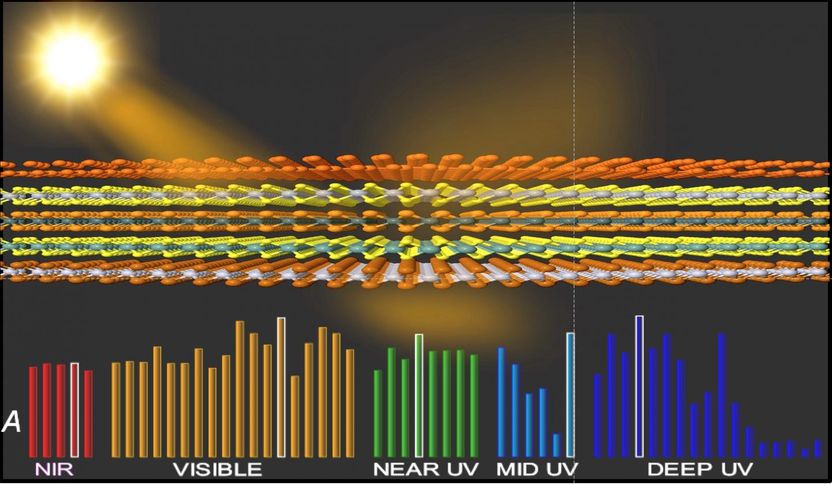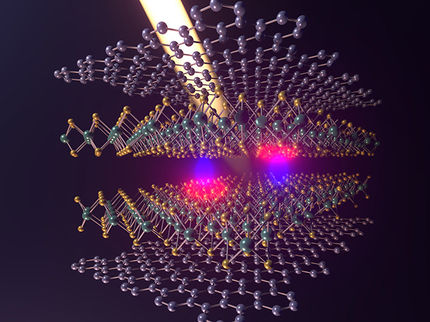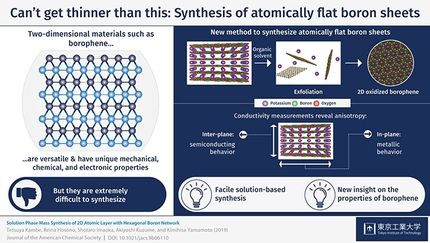Shedding light on - and through - 2D materials
The ability of metallic or semiconducting materials to absorb, reflect and act upon light is of primary importance to scientists developing optoelectronics - electronic devices that interact with light to perform tasks. Rice University scientists have now produced a method to determine the properties of atom-thin materials that promise to refine the modulation and manipulation of light.

Rice University researchers modeled two-dimensional materials to quantify how they react to light. They calculated how the atom-thick materials in single or stacked layers would transmit, absorb and reflect light. The graphs above measure the maximum absorbance of several of the 55 materials tested.
Yakobson Research Group/Rice University
Two-dimensional materials have been a hot research topic since graphene, a flat lattice of carbon atoms, was identified in 2001. Since then, scientists have raced to develop, either in theory or in the lab, novel 2D materials with a range of optical, electronic and physical properties.
Until now, they have lacked a comprehensive guide to the optical properties those materials offer as ultrathin reflectors, transmitters or absorbers.
The Rice lab of materials theorist Boris Yakobson took up the challenge. Yakobson and his co-authors, graduate student and lead author Sunny Gupta, postdoctoral researcher Sharmila Shirodkar and research scientist Alex Kutana, used state-of-the-art theoretical methods to compute the maximum optical properties of 55 2D materials.
"The important thing now that we understand the protocol is that we can use it to analyze any 2D material," Gupta said. "This is a big computational effort, but now it's possible to evaluate any material at a deeper quantitative level."
Their work details the monolayers' transmittance, absorbance and reflectance, properties they collectively dubbed TAR. At the nanoscale, light can interact with materials in unique ways, prompting electron-photon interactions or triggering plasmons that absorb light at one frequency and emit it in another.
Manipulating 2D materials lets researchers design ever smaller devices like sensors or light-driven circuits. But first it helps to know how sensitive a material is to a particular wavelength of light, from infrared to visible colors to ultraviolet.
"Generally, the common wisdom is that 2D materials are so thin that they should appear to be essentially transparent, with negligible reflection and absorption," Yakobson said. "Surprisingly, we found that each material has an expressive optical signature, with a large portion of light of a particular color (wavelength) being absorbed or reflected."
The co-authors anticipate photodetecting and modulating devices and polarizing filters are possible applications for 2D materials that have directionally dependent optical properties. "Multilayer coatings could provide good protection from radiation or light, like from lasers," Shirodkar said. "In the latter case, heterostructured (multilayered) films -- coatings of complementary materials -- may be needed. Greater intensities of light could produce nonlinear effects, and accounting for those will certainly require further research."
The researchers modeled 2D stacks as well as single layers. "Stacks can broaden the spectral range or bring about new functionality, like polarizers," Kutana said. "We can think about using stacked heterostructure patterns to store information or even for cryptography."
Among their results, the researchers verified that stacks of graphene and borophene are highly reflective of mid-infrared light. Their most striking discovery was that a material made of more than 100 single-atom layers of boron -- which would still be only about 40 nanometers thick -- would reflect more than 99 percent of light from the infrared to ultraviolet, outperforming doped graphene and bulk silver.
There's a side benefit that fits with Yakobson's artistic sensibility as well. "Now that we know the optical properties of all these materials - the colors they reflect and transmit when hit with light - we can think about making Tiffany-style stained-glass windows on the nanoscale," he said. "That would be fantastic!"
Original publication
Other news from the department science
These products might interest you

OCA 200 by DataPhysics
Using contact angle meter to comprehensively characterise wetting behaviour, solids, and liquids
With its intuitive software and as a modular system, the OCA 200 answers to all customers’ needs

Tailor-made products for specific applications by IPC Process Center
Granulates and pellets - we develop and manufacture the perfect solution for you
Agglomeration of powders, pelletising of powders and fluids, coating with melts and polymers

Dursan by SilcoTek
Innovative coating revolutionizes LC analysis
Stainless steel components with the performance of PEEK - inert, robust and cost-effective

Get the chemical industry in your inbox
By submitting this form you agree that LUMITOS AG will send you the newsletter(s) selected above by email. Your data will not be passed on to third parties. Your data will be stored and processed in accordance with our data protection regulations. LUMITOS may contact you by email for the purpose of advertising or market and opinion surveys. You can revoke your consent at any time without giving reasons to LUMITOS AG, Ernst-Augustin-Str. 2, 12489 Berlin, Germany or by e-mail at revoke@lumitos.com with effect for the future. In addition, each email contains a link to unsubscribe from the corresponding newsletter.





























































